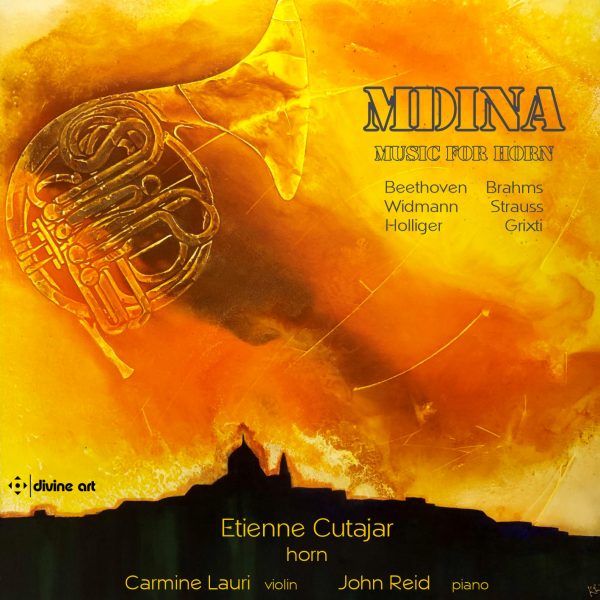The Chronicle
This is a new recording of (as the name suggests) music for horn by Etienne Cutajar, featuring violinist Carmine Lauri and pianist John Reid.
The music comes from Beethoven, Brahms and Richard Strauss as well as modern composers Heinz Holliger, Jesmond Grixti and Jörg Widmann; the work Mdina is by Grixti. Cutajar is principal horn with the Malta Philharmonic Orchestra.
This is an enjoyable album with a varied and interesting sound, thanks to the balance between the more dominant horn and the piano. The variety of styles, from polite chamber music to some more out-there modern music, works well. It’s all very cheery, too.
It opens conventionally enough, with a robust horn fanfare then delicate piano, before the two combine. We listened to this a number of times before looking what anything was; we thought this pleasantly traditional, and it’s Beethoven, Sonata for Horn and Piano. The two instruments give it a warm sound, and the opening movement is an enjoyable eight minutes.
The shorter (1:20) second movement starts off as the first part left off, the horn caressing and more gentle, the piano matching the tone, merging nicely into the third movement, Rondo Allegro.
Air für Horn (1973, from Jörg Widmann), sees the mood change, opening with a more mournful horn, a kind of slower take of Thus Spake Zarathustra’s opening bars, mournful becoming more raucous as the piece proceeds. Say the sleeve notes: “Widmann…fluctuates between open and stopped notes creating a natural work on the themes of proximity and distance.”
Strauss’s Andante for Horn and Piano is a more fluid piece, with sombre keyboard, almost the soundtrack music for a Scandi noir television show.
The title track is next, Mdina seeing more solo riffing and a modern sound, daring and adventuresome. The sleeve notes say that classical pieces for horn are uncommon, but Grixti took up the challenge of writing not just solo but unaccompanied works for the horn. “By removing the support of a ‘harmony’ instrument such as the pianoforte, composers bring the horn’s sound qualities to the fire, exploiting the instrument’s traditions” say the notes.
Brahms closes, and we return to a more traditional sound.
It is – without being condescending – a nice little album, in as much as it sets out to be no more that it is, and it’s got a definite warmth and even sense of fun. Very enjoyable.
@divineartrecordingsgroup
A First Inversion Company
Registered Office:
176-178 Pontefract Road, Cudworth, Barnsley S72 8BE
+44 1226 596703
Fort Worth, TX 76110
+1.682.233.4978










![Listen to the full suite of Marcel Dupré’s Variations Sur un Noël, Op. 20 from Alexander Ffinch’s #Expectations release today! listn.fm/expectations [in bio]](https://scontent-dfw5-1.cdninstagram.com/v/t51.71878-15/588904367_2327488161082898_8709236950834211856_n.jpg?stp=dst-jpg_e35_tt6&_nc_cat=105&ccb=7-5&_nc_sid=18de74&efg=eyJlZmdfdGFnIjoiQ0xJUFMuYmVzdF9pbWFnZV91cmxnZW4uQzMifQ%3D%3D&_nc_ohc=H8WFKm530VcQ7kNvwGJTOnt&_nc_oc=AdkGTCoDBixv0J9wbvsYiiH_mUYUp0_AXMb49yN4TBuHtdO9_Zxj1f6E4PfUgaNL874&_nc_zt=23&_nc_ht=scontent-dfw5-1.cdninstagram.com&edm=ANo9K5cEAAAA&_nc_gid=CGA4WUyFdKt00-b-cBDekw&oh=00_Afng1589uvlzp8DHxgTQzEfmh8QksIRlHryFYLw2rE1Acw&oe=6954F8AA)

![“the ‘Manteca’ Paraphrase – a rare foray into the two-piano medium but here played double-tracked – exudes a panache of which Dizzy Gillespie would surely have approved.… [a] recital well worth investigating.” —Gramophone Magazine with high praise for Ophelia Gordon's debut release, Kapustin: Between the Lines!](https://scontent-dfw5-3.cdninstagram.com/v/t51.82787-15/598796470_18303255136283342_540941604740887837_n.jpg?stp=dst-jpg_e35_tt6&_nc_cat=108&ccb=7-5&_nc_sid=18de74&efg=eyJlZmdfdGFnIjoiRkVFRC5iZXN0X2ltYWdlX3VybGdlbi5DMyJ9&_nc_ohc=IC4zZ7tcpb8Q7kNvwHWz3P7&_nc_oc=AdmHfOMIjNYCiYztoZcWus6bwEXSJxPgFVDvda0E-84xXyWDegl4fPgKFGaSNanArDU&_nc_zt=23&_nc_ht=scontent-dfw5-3.cdninstagram.com&edm=ANo9K5cEAAAA&_nc_gid=CGA4WUyFdKt00-b-cBDekw&oh=00_Afn2iAdTQudgxR9VSIcKwF_kqts4KGxP2IM7z561VxV1HA&oe=69550B44)